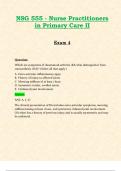Exam (elaborations)
NSG555 / NSG 555 Exam 4 (Latest 2024 / 2025 Update): Nurse Practitioners in Primary Care I | Questions and Verified Answers | 100% Correct | Grade A - Wilkes
- Course
- NSG 555 (NSG555)
- Institution
- Wilkes University
Exam 4: NSG555 / NSG 555 (Latest 2024 / 2025 Update) - Nurse Practitioners in Primary Care II Exam | Questions and Verified Answers | 100% Correct | Grade A - Wilkes Q: Which are symptoms of rheumatoid arthritis (RA) that distinguish it from osteoarthritis (OA)? (Select all that apply.) Extra-artic...
[Show more]



